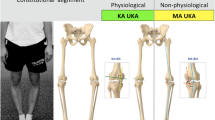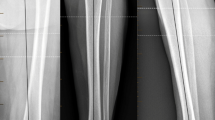Abstract
Purpose
The literature suggests that “forgotten” knees are the most stable knees postoperatively. The main objective of our study was to determine whether a systematic alignment (mechanical, anatomical or kinematic) makes it possible to stabilise the operated joint in extension and in flexion.
Methods
This monocentric prospective cohort study was conducted between May 1st, 2021 and October 31st, 2021. A total of 132 consecutive patients undergoing primary navigated total knee arthroplasty were included, with a mean age of 72.4 years (7.9; 48.8–91.2 years), a mean body mass index (BMI) of 28.6 kg/m2 (4.6; 17.6–41.6) and 71.2% (94/132) women. Mechanical, anatomical and kinematic knee alignments were simulated using Kick software for each patient. The primary outcome was the targeted rate of balanced knees for each type of alignment, based on a three-point score, aiming for a 3/3 score for each knee. Our secondary outcome was to characterise the specific implantation finally achieved by the surgeon.
Results
The targeted balance was reached in 10.6% (14/132), 10.6% (14/132) and 12.9% (17/132) of knees with mechanical, anatomical and kinematic alignment simulations, respectively. None of these simulations provided a superior number of balanced knees (p = 0.87). When simulating a patient-specific implantation, the highest score was reached in 89.1% (115/132) of cases.
Conclusion
Systematic alignment simulations achieved knee balance in only 11% of cases. Patient-specific implantation, favouring knee balancing over alignment, allowed an 89% perfect score rate without having to perform any collateral release.
Level of evidence
Case series. Level 4.




Similar content being viewed by others
Data Availability Statement
The data are avialable on request.
References
Azukizawa M, Kuriyama S, Nakamura S, Nishitani K, Lyman S, Morita Y, Furu M, Ito H, Matsuda S (2018) Intraoperative medial joint laxity in flexion decreases patient satisfaction after total knee arthroplasty. Arch Orthop Trauma Surg 138:1143–1150
Bellemans J, D’Hooghe P, Vandenneucker H, Van Damme G, Victor J (2006) Soft tissue balance in total knee arthroplasty: does stress relaxation occur perioperatively? Clin Orthop Relat Res 452:49–52
Berger RA, Crossett LS, Jacobs JJ, Rubash HE (1998) Malrotation causing patellofemoral complications after total knee arthroplasty. Clin Orthop Relat Res 356:144–153
Beswick AD, Wylde V, Gooberman-Hill R, Blom A, Dieppe P (2012) What proportion of patients report long-term pain after total hip or knee replacement for osteoarthritis? A systematic review of prospective studies in unselected patients. BMJ Open 2:e000435
Clatworthy M (2022) Patient-Specific TKA with the VELYSTM Robotic-Assisted Solution. Surg Technol Int. https://doi.org/10.5298/22.STI.40.OS1561
Graichen H, Luderer V, Strauch M, Hirschmann MT, Scior W (2022) Navigated, gap-balanced, adjusted mechanical alignment achieves alignment and balancing goals in a very high percentage but with partially non-anatomical resections. Knee Surg Sports Traumatol Arthrosc. https://doi.org/10.1007/s00167-022-07014-2
Hirschmann MT, Moser LB, Amsler F, Behrend H, Leclerq V, Hess S (2019) Functional knee phenotypes: a novel classification for phenotyping the coronal lower limb alignment based on the native alignment in young non-osteoarthritic patients. Knee Surg Sports Traumatol Arthrosc 27:1394–1402
Howell SM, Roth JD, Hull ML (2014) Kinematic alignment in total knee arthroplasty. 10. https://www.drstevehowell.com/documents/knee%20replacement%20pdfs/kinematic-alignment-in-total-knee-arthroplasty-definition-history-principle.pdf
Hungerford DS, Krackow KA (1985) Total joint arthroplasty of the knee. Clin Orthop Relat Res 192:23–33
Hutt JRB, LeBlanc M-A, Massé V, Lavigne M, Vendittoli P-A (2016) Kinematic TKA using navigation: surgical technique and initial results. Orthop Traumatol Surg Res 102:99–104
Insall JN, Binazzi R, Soudry M, Mestriner LA (1985) Total knee arthroplasty. Clin Orthop Relat Res 192:13–22
Jeffery RS, Morris RW, Denham RA (1991) Coronal alignment after total knee replacement. J Bone Joint Surg Br 73:709–714
Lee YS, Howell SM, Won Y-Y, Lee O-S, Lee SH, Vahedi H, Teo SH (2017) Kinematic alignment is a possible alternative to mechanical alignment in total knee arthroplasty. Knee Surg Sports Traumatol Arthrosc 25:3467–3479
Luo Z, Zhou K, Peng L, Shang Q, Pei F, Zhou Z (2020) Similar results with kinematic and mechanical alignment applied in total knee arthroplasty. Knee Surg Sports Traumatol Arthrosc 28:1720–1735
MacDessi SJ, Griffiths-Jones W, Harris IA, Bellemans J, Chen DB (2021) Coronal plane alignment of the knee (CPAK) classification. Bone Joint J 103-B:329–337
Marmor S, Renault E, Valluy J, Saffarini M (2019) Over-voluming predicted by pre-operative planning in 24% of total knee arthroplasty. Knee Surg Sports Traumatol Arthrosc 27:1544–1551
Mehliß V, Strauch Leira M, Serrano Olaizola A, Scior W, Graichen H (2019) Proven accuracy for a new dynamic gap measurement in navigated TKA. Knee Surg Sports Traumatol Arthrosc 27:1189–1195
Oussedik S, Abdel MP, Victor J, Pagnano MW, Haddad FS (2020) Alignment in total knee arthroplasty. Bone Joint J 102-B:276–279
Pagnano MW, Hanssen AD, Lewallen DG, Stuart MJ (1998) Flexion instability after primary posterior cruciate retaining total knee arthroplasty. Clin Orthop Relat Res 356:39–46
Parratte S, Pagnano MW, Trousdale RT, Berry DJ (2010) Effect of postoperative mechanical axis alignment on the fifteen-year survival of modern, cemented total knee replacements. J Bone Joint Surg Am 92:2143–2149
Pitto RP, Graydon AJ, Bradley L, Malak SF, Walker CG, Anderson IA (2006) Accuracy of a computer-assisted navigation system for total knee replacement. J Bone Joint Surg Br 88:601–605
Ritter MA, Faris PM, Keating EM, Meding JB (1994) Postoperative alignment of total knee replacement. Its effect on survival. Clin Orthop Relat Res (299):153-156
Seah RB, Yeo SJ, Chin PL, Yew AKS, Chong HC, Lo NN (2014) Evaluation of medial-lateral stability and functional outcome following total knee arthroplasty: results of a single hospital joint registry. J Arthroplasty 29:2276–2279
Sharkey PF, Hozack WJ, Rothman RH, Shastri S, Jacoby SM (2002) Why are total knee arthroplasties failing today? Clin Orthop Relat Res 404:7–13
Shatrov J, Batailler C, Sappey-Marinier E, Gunst S, Servien E, Lustig S (2022) Kinematic alignment fails to achieve balancing in 50% of varus knees and resects more bone compared to functional alignment. Knee Surg Sports Traumatol Arthrosc 30:2991–2999
Sikorski JM (2008) Alignment in total knee replacement. J Bone Joint Surg Br 90:1121–1127
Watanabe T, Ishizuki M, Muneta T, Banks S (2012) Matched comparison of kinematics in knees with mild and severe varus deformity using fixed- and mobile-bearing total knee arthroplasty. Clin Biomech (Bristol, Avon) 27:924–928
Young SW, Sullivan NPT, Walker ML, Holland S, Bayan A, Farrington B (2020) No difference in 5-year clinical or radiographic outcomes between kinematic and mechanical alignment in TKA: a randomized controlled trial. Clin Orthop Relat Res 478:1271–1279
Funding
The researchers did not receive any funding to conduct this study.
Author information
Authors and Affiliations
Contributions
P-AB: article design, data collection and analysis, article writing. TA: surgeon, article design and proofreading. SC: data collection and article writing. NG: data collection and proofreading. VLS: surgeon and proofreading. AM: surgeon and proofreading. SM: article design, surgeon, data analysis and article writing.
Corresponding author
Ethics declarations
Conflict of interest
Some authors are consultant for Depuy, Lape, Corin and Amplitude.
Ethical approval
This study was approved by the Comité de Protection des Personnes Nord-Ouest II (CPP) under the N° ID-RCB: 2021-100252-39.
Informed consent
All patients were informed about the study. All patients have given their consent.
Additional information
Publisher's Note
Springer Nature remains neutral with regard to jurisdictional claims in published maps and institutional affiliations.
Rights and permissions
Springer Nature or its licensor (e.g. a society or other partner) holds exclusive rights to this article under a publishing agreement with the author(s) or other rightsholder(s); author self-archiving of the accepted manuscript version of this article is solely governed by the terms of such publishing agreement and applicable law.
About this article
Cite this article
Bouché, PA., Aubert, T., Corsia, S. et al. Systematic alignments yield balanced knees without additional releases in only 11% of knee arthroplasties: a prospective study. Knee Surg Sports Traumatol Arthrosc 31, 1443–1450 (2023). https://doi.org/10.1007/s00167-022-07252-4
Received:
Accepted:
Published:
Issue Date:
DOI: https://doi.org/10.1007/s00167-022-07252-4




